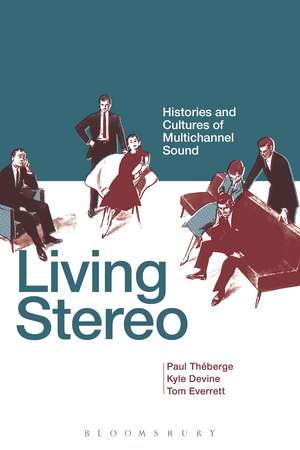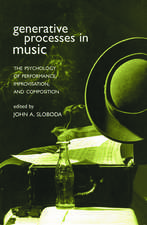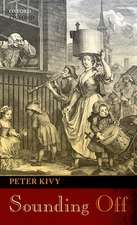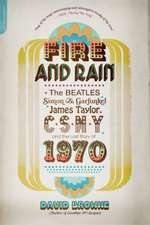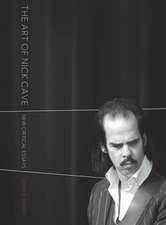Living Stereo: Histories and Cultures of Multichannel Sound
Editat de Paul Théberge, Kyle Devine, Tom Everretten Limba Engleză Paperback – 25 mar 2015
| Toate formatele și edițiile | Preț | Express |
|---|---|---|
| Paperback (1) | 193.80 lei 6-8 săpt. | |
| Bloomsbury Publishing – 25 mar 2015 | 193.80 lei 6-8 săpt. | |
| Hardback (1) | 833.23 lei 6-8 săpt. | |
| Bloomsbury Publishing – 25 mar 2015 | 833.23 lei 6-8 săpt. |
Preț: 193.80 lei
Preț vechi: 224.07 lei
-14% Nou
Puncte Express: 291
Preț estimativ în valută:
37.09€ • 40.27$ • 31.15£
37.09€ • 40.27$ • 31.15£
Carte tipărită la comandă
Livrare economică 22 aprilie-06 mai
Preluare comenzi: 021 569.72.76
Specificații
ISBN-13: 9781623566654
ISBN-10: 1623566657
Pagini: 298
Ilustrații: 8 bw images
Dimensiuni: 152 x 229 x 20 mm
Greutate: 0.46 kg
Editura: Bloomsbury Publishing
Colecția Bloomsbury Academic
Locul publicării:New York, United States
ISBN-10: 1623566657
Pagini: 298
Ilustrații: 8 bw images
Dimensiuni: 152 x 229 x 20 mm
Greutate: 0.46 kg
Editura: Bloomsbury Publishing
Colecția Bloomsbury Academic
Locul publicării:New York, United States
Caracteristici
A focused collection of essays discussing a core subsection of Sound Studies
Notă biografică
Paul Theberge is a Professor cross-appointed to the Institute for Comparative Studies in Literature, Art and Culture (where he was formerly Canada Research Chair and Director) and to the School for Studies in Art and Culture (Music) at Carleton University, Canada.Kyle Devine is Lecturer in Music at City University London, and a research associate with the Music and Digitisation Research Group at the University of Oxford. Tom Everrett is an instructor in the School of Journalism and Communication and member of the Hypertext and Hypermedia digital humanities research centre at Carleton University, Canada.
Cuprins
Table of Contents List of Illustrations Acknowledgements Introduction: Living Stereo (Paul Théberge, Kyle Devine and Tom Everrett) (AUDIO) POSITIONS 1. The "Sweet Spot": The Technology of Stereo and the Field of Auditorship (Tony Grajeda) 2. The Stereophonic Spaces of Soundscape (Jonathan Sterne) 3. Sonar and the Channelization of the Ocean (John Shiga) LISTENING CULTURES 4. Training the Listener: Stereo Demonstration Discs in an Emerging Consumer Market (Tim J. Anderson) 5. Mono in the Stereo Age (Eric Barry) 6. Looking Past the Stereo Loudspeakers: From the Home to the Amplified Concert Hall (Jonathan Tee) 7. Recorded British Folk Song (Allan F. Moore) MULTICHANNEL SOUND and SCREEN MEDIA 8. Television: Now with Two Channels of Audio (David Sedman) 9. The Grandeur(s) of CinemaScope (Matthew Malsky) 10. Atmos Now: Dolby Laboratories, Mixing Ideology and Hollywood Sound Production (Benjamin Wright) 11. A Symphony of Sound: Surround Sound in Formula One Racing Games (Ruth Dockwray and Karen Collins) List of Contributors Index
Recenzii
In this volume, Théberge, Devine and Everrett have gathered together a fascinating body of writing on the technical, psychological and social construction of stereo. The collection represents another important step in the growing body of scholarship on how recorded music differs from music on the concert stage and in the score. While the individual chapters provide some fine grained detail, the editors have situated them into the broader context of the burgeoning new discipline of sound studies.
This timely, rich and compelling book traces the staging of auditory perspective and experience in stereo sound at home, the concert hall, the cinema and beyond. It situates stereo sound so carefully in historical and contemporary cultures of science, commerce and listening that the book is itself a "sweet spot" in studies of sound and music.
Sound technology is increasingly understood as sound technologies. There is no single technology that informs the recording and reproduction of sound, but a vast array of different technologies, drawn from the separate fields of telephony, music recording, radio, film, television, and gaming, not to mention military applications of sound technology used in sonar equipment. As the study of individual sound technologies has evolved into the new field of "sound studies," scholars have begun to rethink the relations between and among different forms of sound technology. Living Stereo provides a site and a topic that serves as an exemplary model of recent scholarship on sound from the vantage point of outstanding scholars drawn from an array of disparate fields. The result is a multi-channel portrait-perhaps "soundscape" would be a better term--of stereophonic sound from the 1880s to the present.
Like the best of anthologies, Living Stereo not only brings together a broad array of exciting work on its subject but also suggests that much work remains to be done. Rather than simply previewing the essays that follow, the introduction provides a conceptual basis for future engagements with stereo (and indeed other media technologies) in terms of technological practices, systems of cultural assumptions, and the intersection of commercial constraints and the logistics of listening.
".A collection of clearly keen intellects deconstructing hitherto tacitly accepted "truths" about stereo production and consumption, in a manner that usually causes the reader to question what they actually know about these topics. The quality of the scholarship and clarity of the writing is excellent, and each chapter boasts healthy bibliographic citations and commentary that regularly motivated me to follow sources and learn more.the value of the individual essays is so high that it easily earns its place on library shelves and in private collections.
This timely, rich and compelling book traces the staging of auditory perspective and experience in stereo sound at home, the concert hall, the cinema and beyond. It situates stereo sound so carefully in historical and contemporary cultures of science, commerce and listening that the book is itself a "sweet spot" in studies of sound and music.
Sound technology is increasingly understood as sound technologies. There is no single technology that informs the recording and reproduction of sound, but a vast array of different technologies, drawn from the separate fields of telephony, music recording, radio, film, television, and gaming, not to mention military applications of sound technology used in sonar equipment. As the study of individual sound technologies has evolved into the new field of "sound studies," scholars have begun to rethink the relations between and among different forms of sound technology. Living Stereo provides a site and a topic that serves as an exemplary model of recent scholarship on sound from the vantage point of outstanding scholars drawn from an array of disparate fields. The result is a multi-channel portrait-perhaps "soundscape" would be a better term--of stereophonic sound from the 1880s to the present.
Like the best of anthologies, Living Stereo not only brings together a broad array of exciting work on its subject but also suggests that much work remains to be done. Rather than simply previewing the essays that follow, the introduction provides a conceptual basis for future engagements with stereo (and indeed other media technologies) in terms of technological practices, systems of cultural assumptions, and the intersection of commercial constraints and the logistics of listening.
".A collection of clearly keen intellects deconstructing hitherto tacitly accepted "truths" about stereo production and consumption, in a manner that usually causes the reader to question what they actually know about these topics. The quality of the scholarship and clarity of the writing is excellent, and each chapter boasts healthy bibliographic citations and commentary that regularly motivated me to follow sources and learn more.the value of the individual essays is so high that it easily earns its place on library shelves and in private collections.
